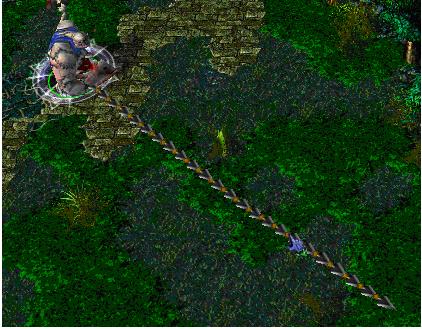- 线段树学习札记
Cool_(wly)_Dino
学习数据结构算法c++
线段树维护序列的树形数据结构——线段树面对以下问题luoguP3372,给出一个数列:(1)将区间【x,y】内每一个数加上k(2)求出某个区间【x,y】中每一个数的和。虽然普通方法修改复杂度O(1)但是求和的效率却是O(n)线段树的思想个人来讲就是归并,线段树所维护的信息必须具有可合并性,个人认为其实现原理过于基础,不做分析。一些有意思的证明:对于节点数为n深度为h的一棵树,其深度可以表示为(n+
- 洛谷模板汇整
Alaso_shuang
算法分类算法
普及-P3378【模板】堆P3367【模板】并查集P1177【模板】快速排序P3383【模板】线性筛素数P3370【模板】字符串哈希P3366【模板】最小生成树P1226【模板】快速幂||取余运算普及/提高-P3385【模板】负环P3865【模板】ST表P8306【模板】字典树P5788【模板】单调栈P3811【模板】乘法逆元P4549【模板】裴蜀定理P3372【模板】线段树1P3382【模板】三
- 树状数组(二叉索引树)
椰萝Yerosius
板子数据结构算法
树状数组(二叉索引树)树状数组的核心思想:分治。将数组以二叉树的逻辑结构进行组织。树状数组巧妙的利用了下标的二进制特性,以维护区间信息。树状数组并非一棵真正的二叉树,以二叉树的存储结构进行组织的为线段树。lowbit\texttt{lowbit}lowbit操作:获取整数最低位的1的位置。由于0的lowbit\texttt{lowbit}lowbit没有意义,因此树状数组下标需从1开始。intlo
- 研究线段树的最大子段和
数据掘金
java算法数据库
我们可以分析出上题就是带修改的最大子段和[-](http://jvquant.com/wiki/行情/解析行情.html)遇到这种类型的题目应该想到用线段树[-](http://jvquant.com/wiki/行情/订阅/美股行情订阅.html)实现对于原数列,先建起一棵线段树,每个节点包含最大前缀、最大后缀、最大字段和、区间和信息[-]()当你明确一道题是线段树时,要先思考pushup和pus
- 【封印宝石——线段树】
Kent_J_Truman
蓝桥杯算法
题目分析封印宝石题解https://www.acwing.com/solution/content/261922/代码#includeusingnamespacestd;usingpll=pair;#definexfirst#defineysecondconstintN=1e5+10;structnode{intl,r;intv1,v2;inti1,i2;}tr[4*N];intn,k,a[N],
- 一些关于数据结构的杂谈
超闻逸事
算法c++算法笔记数据结构
树链剖分P3384【模板】轻重链剖分/树链剖分作用维护树上路径的相关信息。常与线段树相结合。性质所有节点都属于且仅属于一条重链,重链将树完全剖分。重链与子树内的dfs\texttt{dfs}dfs序连续。【这一个性质非常有用】每一条路径最多被拆分成logn\lognlogn条重链(向下经过一条轻边时,子树大小至少除以222)。一些定义f[x]节点xxx的父亲。sz[x]节点xxx对应的子树大小。
- Leetcode3165:不包含相邻元素子序列的最大和
ʚ发什么呆^ɞ
算法数据结构
代码思路这段代码实现了一个特殊类型的线段树(SegmentTree),用于解决一类特定的动态规划问题,具体来说,是求解一系列更新操作后,一个特定子序列和的最大值问题。这里的子序列和受到一些特定的约束条件影响,这些条件通过线段树的节点(SegNode)中的四个值(v00,v01,v10,v11)来体现。以下是对代码思路的详细解释:数据结构定义SegNode结构体:包含四个longlong类型的成员变
- XVIII Open Cup named after E.V. Pankratiev. GP of Urals
weixin_33738578
ui
A.Nutella’sLife斜率优化DP显然,CDQ分治后按$a$排序建线段树,每层维护凸包,查询时不断将队首弹出即可。时间复杂度$O(n\log^2n)$。#include#includeusingnamespacestd;typedeflonglongll;typedefpairP;constintN=100010,M=262150;intn,i,a[N],cb;llf[N],g[N],w[
- Nutella’s Life-斜率优化+线段树
bensanhuan
题解动态规划数据结构
如有疏漏错误之处,请多指教题意codeforce.com发布了未来一年的比赛列表。未来一年将会有n(1≤n≤105)n(1\leqn\leq10^{5})n(1≤n≤105)场比赛。小红为每场比赛计算了一个快乐值a[i](10−9≤a[i]≤109)a[i](10^{-9}\leqa[i]\leq10^{9})a[i](10−9≤a[i]≤109)。小红参加比赛的规则和快乐值获取规则如下:如果小红
- 深入解析线段树-构建原理与区间查询优化
一键难忘
算法之翼算法线段树动态规划宽度优先深度优先
本文收录于专栏:算法之翼深入解析线段树-构建原理与区间查询优化线段树(SegmentTree)是一种高级数据结构,常用于处理区间查询与动态更新问题。在许多应用中,例如数组的区间和查询,区间最值查询,线段树都能够提供高效的解决方案。本文将深入探讨线段树的构建原理,并结合实际代码示例,讨论如何优化区间查询。1.线段树的基本原理线段树是一棵二叉树,每个节点对应数组的一个区间。叶节点存储数组的单个元素,内
- 线段树知识点总结和学习心得分享
GA_PK
线段树主要用来维护复杂的区间信息.只要满足区间可加性,线段树基本都可以解决.1.线段树基本操作(单点更新,区间求和等不涉及lazy标记问题)先来讲建树问题,线段树建树有很多种方法,本文介绍的是把一个区间划分成为[l,mid],[mid+1,r]的建树方法.我们会把一个大区间分成若干个小区间,tree[1]是表示整个大区间.把它分成两个小区间.用下标tree[2×father],tree[2×fat
- 7.3.6 蓝桥杯基础数据结构之线段树维护哈希
夏驰和徐策
蓝桥杯哈希算法数据结构蓝桥杯线段树
7.3.6蓝桥杯基础数据结构之线段树维护哈希引言在编程竞赛和算法设计中,线段树是处理区间问题的强大工具。结合哈希,线段树可以高效地处理字符串和其他序列数据的复杂查询。本文将探讨如何在蓝桥杯等编程竞赛中使用线段树维护哈希值。基础概念线段树线段树是一种二叉树结构,用于高效处理区间相关的查询和更新操作。它将一个区间分割成更小的子区间,使得对这些子区间的操作更加高效。哈希哈希在处理字符串和序列数据时尤为重
- 模板分享:线段树(1)
pystraf
数据结构与算法#数据结构算法数据结构c++线段树
Code先放代码templatestructsegment{private:#definels(u*2+1)#definers(u*2+2)structNode{intl,r;Infoinfo;};vectortr;public:usinginfo_type=Info;segment(){}segment(intn,Infov=Info()){vectora(n,v);init(a);}templ
- 模板分享:线段树(2)
pystraf
数据结构与算法#数据结构c++算法数据结构线段树
Code先放代码:#include#includeusingnamespacestd;templatestructlazy_segment{private:#definels(u*2+1)#definers(u*2+2)structNode{intl,r;Infoinfo;Tagtag;};vectortr;public:usinginfo_type=Info;usingtag_type=Tag;
- 洛谷P3372 【模板】线段树 1
xwztdas
数据结构
洛谷题目传送门题目描述如题,已知一个数列,你需要进行下面两种操作:将某区间每一个数加上k。求出某区间每一个数的和。输入格式第一行包含两个整数,,分别表示该数列数字的个数和操作的总个数。第二行包含个用空格分隔的整数,其中第个数字表示数列第项的初始值。接下来行每行包含3或4个整数,表示一个操作,具体如下:1xyk:将区间[,]内每个数加上k。2xy:输出区间[,]内每个数的和。输出格式输出包含若干行整
- 「分块」数列分块入门1 – 9 by hzwer 解题记录
GA_PK
出处学习蓝书的时候感觉书上关于分块的题目太少了.而且都是难度较大的一些分块题目,想巩固一下分块方面的知识,就找到了hzwer大佬的分块入门知识介绍.用这篇博客记录一下.从树状数组到线段树再到分块.都是对区间信息的快速处理来达到想要的效果.树状数组效率最优,可是拓展性实在不高.线段树效率稍微差一点但是拓展性较好,可是在信息不满足区间可加性的情况下代码难度会高很多.而分块效率上最差但是可以接受,且拓展
- 洛谷 P3372:线段树 1 ← 分块算法模板(区间更新、区间查询)
hnjzsyjyj
信息学竞赛#分治算法与双指针分块
【题目来源】https://www.luogu.com.cn/problem/P3372【题目描述】如题,已知一个数列,你需要进行下面两种操作:(1)将某区间每一个数加上k。(2)求出某区间每一个数的和。【输入格式】第一行包含两个整数n,m,分别表示该数列数字的个数和操作的总个数。第二行包含n个用空格分隔的整数,其中第i个数字表示数列第i项的初始值。接下来m行每行包含3或4个整数,表示一个操作,具
- 分块算法详解
justin666888
C++数据结构C++算法数据结构关键字数据结构算法
分块算法详解一.啥是分块二.分块的操作1.分组2.区间加法&单点查询3.区间加法&询问区间内小于某个值x的元素个数4.区间求和&区间加法5.区间开方&区间求和6.单点插入&单点询问7.区间加法&区间前驱8.区间乘法&区间加法&单点询问9.区间某值个数&区间赋值10.区间众数三.分块算法时间复杂度分析1.时间复杂度2.万恶的卡常四.分块算法与线段树对比五.例题一.啥是分块分块,顾名思义,就是把一个东
- 最好的线段树总结
QYitong
数据结构c语言ACM数据结构线段树
线段树详解By岩之痕目录:一:综述二:原理三:递归实现四:非递归原理五:非递归实现六:线段树解题模型七:扫描线八:可持久化(主席树)九:练习题一:综述假设有编号从1到n的n个点,每个点都存了一些信息,用[L,R]表示下标从L到R的这些点。线段树的用处就是,对编号连续的一些点进行修改或者统计操作,修改和统计的复杂度都是O(log2(n)).线段树的原理,就是,将[1,n]分解成若干特定的子区间(数量
- [线段树(猫树)] 最大连续和
Jcqsunny
算法c++线段树猫树
题目描述给出一个含有NNN个结点的环,编号分别为1…N1\ldotsN1…N,环上的点带有权值(可正可负),现要动态的修改某个点的权值,求每次修改后环上的最大连续和,但不能是整个序列的和。输入格式第一行为一个整数NNN。第二行为NNN个用空格分开的整数。第三行为一个整数M(4≤M≤100000)M(4\leM\le100000)M(4≤M≤100000),表示修改的次数(绝对值小于等于100010
- 归并排序(Ologn)及其应用(求逆序对)+例题(后续仍有补充)
万般算法皆思想
这几天一直在看lrj紫书的归并排序部分,刚开始连递归都看不懂,,现在已经完全理解了,写这个bolg就是为了记录一下板子,方便以后进行记忆唤醒。之后陆续还会学习补充树状数组和线段树,这三者其实都是二分思想的应用,最关键的不是记住这个板子,而是能够理解其中的思想。归并排序又是分治法的一种应用,分为分和治两部分。分即为根据递归,将数组一直划分到只剩两个元素的时候,这个时候问题就很简单了,而治又是从两个元
- 在 MoonBit 实现线段树(二)
编程语言
引言在上一篇文章当中我们讨论了最基础线段树的实现,但那棵线段树只能做到区间的查询(当然单点的修改与查询也是可以的),但做不到区间的修改(一个经典的应用是区间加法,即整个区间都加上某个值)。在本节当中我们将基于上次的线段树继续加深抽象,引入LazyTag的概念来解决区间修改的问题,完成一棵功能基本完备的线段树。怎么做到区间修改?先设想如果我们在线段树上给一个区间都加上某个数会发生什么?或者换种说法,
- 编程实践|用 MoonBit 实现线段树(一)
编程语言
引言线段树(SegmentTree)是一种常见的数据结构,用于解决一些线性区间的修改、查询问题,比如对于问题:给出一个长度已知的、有初值的数字数组,接下来要进行许多区间加法操作(将一个区间的数值都加上某个值)和区间求和操作(求该区间数值的和并输出)如果该问题使用正常的数组方式来遍历求解,假设该数组长度为N,每次修改和查询的操作耗时是O(N)的;但线段树经过O(NlogN)的构建之后,可以对上述两个
- BZOJ 五月胡乱补题
nike0good
其他屯题bzoj博客补档
旧博客搬运部分格式还没来得及改T_T【BZOJ4806:炮】同BZOJ1801【BZOJ3242:[Noi2013]快餐店】树形dp,要么最远点在同一颗树上(dp),要么在不同树上,此时答案=去掉任何一条边后形成的树的答案的最小值,我们枚举去掉的那条边。由于答案=s[i]-s[j]+dis[i]+dis[j],i,j可以分开考虑,也可以用线段树解决。【BZOJ4878:[Lydsy2017年5月月
- 线段树(模板)
数学收藏家
线段树
#includeusingnamespacestd;#defineintlonglong#defineendl'\n'#defineIOSios::sync_with_stdio(false);cin.tie(0);cout.tie(0);#definemaxn100005intn,q;inta[maxn];structnode{intval,lazy;}s[maxn*4];voidpush_up
- CCF-CSP认证考试(第32次)总结+题解
Romanticroom
算法
总结:这一次我选了时间较近的一次进行练习,结果有点悲,前两题就一个质因数分解还好,第三题我走了弯路,想通过类似线段树的手段处理,结果还差了系数,最后一个点tle了。。。第四题直接放弃了。。(太菜,没脸见人)第五题还抱有幻想,当然也只有幻想。。后两题只能打暴力了,以我现在水平,希望努力一个月能有所改变吧。题解:(这里只给到三题题解,再往后我也不会了。。)题一:仓库规划西西艾弗岛上共有n个仓库,依次编
- 数据结构入门(5)——树与二叉树的应用
Dusk Cteator
高级语言程序设计数据结构笔记数据结构算法霍夫曼树二叉树c++
数据结构入门——树与二叉树的应用文章目录数据结构入门——树与二叉树的应用前言一、压缩与哈夫曼树扩充二叉树哈夫曼算法哈夫曼算法基本思想哈夫曼算法哈夫曼编码二、表达式树如何构造表达式二叉树计算表达式二叉树对应的值三、并查集并查集的实现四、初探线段树与树状数组线段树线段树操作树状数组定义操作树状数组和线段树前言本系列文章将简要介绍数据结构课程入门知识,文章将结合我们学校(吉大)数据结构课程内容进行讲述。
- 线段树
Cheng Yu
线段树线段树
基础知识1、线段树是二叉树,且必定是平衡二叉树,但不一定是完全二叉树。2、对于区间[L,R],令mid=(L+R)/2,则其左子树为[L,mid],右子树为[mid+1,R],当L==R时,该区间为线段树的叶子,无需继续往下划分。3、线段树虽然不是完全二叉树,但是可以用完全二叉树的方式去构造并存储它,只是最后一层可能存在某些叶子与叶子之间出现“空叶子”,这个无需理会,同样给空叶子按顺序编号,在遍历
- 【详解】线段树
CH_Vaniteux
详解数据结构线段树
线段树详解By岩之痕目录:一:综述二:原理三:递归实现四:非递归原理五:非递归实现六:线段树解题模型七:扫描线八:可持久化(主席树)九:练习题一:综述假设有编号从1到n的n个点,每个点都存了一些信息,用[L,R]表示下标从L到R的这些点。线段树的用处就是,对编号连续的一些点进行修改或者统计操作,修改和统计的复杂度都是O(log2(n)).线段树的原理,就是,将[1,n]分解成若干特定的子区间(数量
- CF 967 D. Longest Max Min Subsequence
Jiu-yuan
算法数据结构
原题链接:Problem-D-Codeforces题意:多测,每次给出长度为n的数组,要求找出没有重复元素的,最长的子序列,如果不止一个最长子序列,那么就选择字典序最小的,比较字典序的时候,如果这个元素的下标是奇数,那么就变成负数比较。思路:线段树+贪心,观察题意可知,最终的子序列肯定是正负相间的,那么对于奇数位置,这个数越大越好,对于偶数位置,这个数越小越好。那么就可以贪心的考虑这个问题,设置二
- ASM系列四 利用Method 组件动态注入方法逻辑
lijingyao8206
字节码技术jvmAOP动态代理ASM
这篇继续结合例子来深入了解下Method组件动态变更方法字节码的实现。通过前面一篇,知道ClassVisitor 的visitMethod()方法可以返回一个MethodVisitor的实例。那么我们也基本可以知道,同ClassVisitor改变类成员一样,MethodVIsistor如果需要改变方法成员,注入逻辑,也可以
- java编程思想 --内部类
百合不是茶
java内部类匿名内部类
内部类;了解外部类 并能与之通信 内部类写出来的代码更加整洁与优雅
1,内部类的创建 内部类是创建在类中的
package com.wj.InsideClass;
/*
* 内部类的创建
*/
public class CreateInsideClass {
public CreateInsideClass(
- web.xml报错
crabdave
web.xml
web.xml报错
The content of element type "web-app" must match "(icon?,display-
name?,description?,distributable?,context-param*,filter*,filter-mapping*,listener*,servlet*,s
- 泛型类的自定义
麦田的设计者
javaandroid泛型
为什么要定义泛型类,当类中要操作的引用数据类型不确定的时候。
采用泛型类,完成扩展。
例如有一个学生类
Student{
Student(){
System.out.println("I'm a student.....");
}
}
有一个老师类
- CSS清除浮动的4中方法
IT独行者
JavaScriptUIcss
清除浮动这个问题,做前端的应该再熟悉不过了,咱是个新人,所以还是记个笔记,做个积累,努力学习向大神靠近。CSS清除浮动的方法网上一搜,大概有N多种,用过几种,说下个人感受。
1、结尾处加空div标签 clear:both 1 2 3 4
.div
1
{
background
:
#000080
;
border
:
1px
s
- Cygwin使用windows的jdk 配置方法
_wy_
jdkwindowscygwin
1.[vim /etc/profile]
JAVA_HOME="/cgydrive/d/Java/jdk1.6.0_43" (windows下jdk路径为D:\Java\jdk1.6.0_43)
PATH="$JAVA_HOME/bin:${PATH}"
CLAS
- linux下安装maven
无量
mavenlinux安装
Linux下安装maven(转) 1.首先到Maven官网
下载安装文件,目前最新版本为3.0.3,下载文件为
apache-maven-3.0.3-bin.tar.gz,下载可以使用wget命令;
2.进入下载文件夹,找到下载的文件,运行如下命令解压
tar -xvf apache-maven-2.2.1-bin.tar.gz
解压后的文件夹
- tomcat的https 配置,syslog-ng配置
aichenglong
tomcathttp跳转到httpssyslong-ng配置syslog配置
1) tomcat配置https,以及http自动跳转到https的配置
1)TOMCAT_HOME目录下生成密钥(keytool是jdk中的命令)
keytool -genkey -alias tomcat -keyalg RSA -keypass changeit -storepass changeit
- 关于领号活动总结
alafqq
活动
关于某彩票活动的总结
具体需求,每个用户进活动页面,领取一个号码,1000中的一个;
活动要求
1,随机性,一定要有随机性;
2,最少中奖概率,如果注数为3200注,则最多中4注
3,效率问题,(不能每个人来都产生一个随机数,这样效率不高);
4,支持断电(仍然从下一个开始),重启服务;(存数据库有点大材小用,因此不能存放在数据库)
解决方案
1,事先产生随机数1000个,并打
- java数据结构 冒泡排序的遍历与排序
百合不是茶
java
java的冒泡排序是一种简单的排序规则
冒泡排序的原理:
比较两个相邻的数,首先将最大的排在第一个,第二次比较第二个 ,此后一样;
针对所有的元素重复以上的步骤,除了最后一个
例题;将int array[]
- JS检查输入框输入的是否是数字的一种校验方法
bijian1013
js
如下是JS检查输入框输入的是否是数字的一种校验方法:
<form method=post target="_blank">
数字:<input type="text" name=num onkeypress="checkNum(this.form)"><br>
</form>
- Test注解的两个属性:expected和timeout
bijian1013
javaJUnitexpectedtimeout
JUnit4:Test文档中的解释:
The Test annotation supports two optional parameters.
The first, expected, declares that a test method should throw an exception.
If it doesn't throw an exception or if it
- [Gson二]继承关系的POJO的反序列化
bit1129
POJO
父类
package inheritance.test2;
import java.util.Map;
public class Model {
private String field1;
private String field2;
private Map<String, String> infoMap
- 【Spark八十四】Spark零碎知识点记录
bit1129
spark
1. ShuffleMapTask的shuffle数据在什么地方记录到MapOutputTracker中的
ShuffleMapTask的runTask方法负责写数据到shuffle map文件中。当任务执行完成成功,DAGScheduler会收到通知,在DAGScheduler的handleTaskCompletion方法中完成记录到MapOutputTracker中
- WAS各种脚本作用大全
ronin47
WAS 脚本
http://www.ibm.com/developerworks/cn/websphere/library/samples/SampleScripts.html
无意中,在WAS官网上发现的各种脚本作用,感觉很有作用,先与各位分享一下
获取下载
这些示例 jacl 和 Jython 脚本可用于在 WebSphere Application Server 的不同版本中自
- java-12.求 1+2+3+..n不能使用乘除法、 for 、 while 、 if 、 else 、 switch 、 case 等关键字以及条件判断语句
bylijinnan
switch
借鉴网上的思路,用java实现:
public class NoIfWhile {
/**
* @param args
*
* find x=1+2+3+....n
*/
public static void main(String[] args) {
int n=10;
int re=find(n);
System.o
- Netty源码学习-ObjectEncoder和ObjectDecoder
bylijinnan
javanetty
Netty中传递对象的思路很直观:
Netty中数据的传递是基于ChannelBuffer(也就是byte[]);
那把对象序列化为字节流,就可以在Netty中传递对象了
相应的从ChannelBuffer恢复对象,就是反序列化的过程
Netty已经封装好ObjectEncoder和ObjectDecoder
先看ObjectEncoder
ObjectEncoder是往外发送
- spring 定时任务中cronExpression表达式含义
chicony
cronExpression
一个cron表达式有6个必选的元素和一个可选的元素,各个元素之间是以空格分隔的,从左至右,这些元素的含义如下表所示:
代表含义 是否必须 允许的取值范围 &nb
- Nutz配置Jndi
ctrain
JNDI
1、使用JNDI获取指定资源:
var ioc = {
dao : {
type :"org.nutz.dao.impl.NutDao",
args : [ {jndi :"jdbc/dataSource"} ]
}
}
以上方法,仅需要在容器中配置好数据源,注入到NutDao即可.
- 解决 /bin/sh^M: bad interpreter: No such file or directory
daizj
shell
在Linux中执行.sh脚本,异常/bin/sh^M: bad interpreter: No such file or directory。
分析:这是不同系统编码格式引起的:在windows系统中编辑的.sh文件可能有不可见字符,所以在Linux系统下执行会报以上异常信息。
解决:
1)在windows下转换:
利用一些编辑器如UltraEdit或EditPlus等工具
- [转]for 循环为何可恨?
dcj3sjt126com
程序员读书
Java的闭包(Closure)特征最近成为了一个热门话题。 一些精英正在起草一份议案,要在Java将来的版本中加入闭包特征。 然而,提议中的闭包语法以及语言上的这种扩充受到了众多Java程序员的猛烈抨击。
不久前,出版过数十本编程书籍的大作家Elliotte Rusty Harold发表了对Java中闭包的价值的质疑。 尤其是他问道“for 循环为何可恨?”[http://ju
- Android实用小技巧
dcj3sjt126com
android
1、去掉所有Activity界面的标题栏
修改AndroidManifest.xml 在application 标签中添加android:theme="@android:style/Theme.NoTitleBar"
2、去掉所有Activity界面的TitleBar 和StatusBar
修改AndroidManifes
- Oracle 复习笔记之序列
eksliang
Oracle 序列sequenceOracle sequence
转载请出自出处:http://eksliang.iteye.com/blog/2098859
1.序列的作用
序列是用于生成唯一、连续序号的对象
一般用序列来充当数据库表的主键值
2.创建序列语法如下:
create sequence s_emp
start with 1 --开始值
increment by 1 --増长值
maxval
- 有“品”的程序员
gongmeitao
工作
完美程序员的10种品质
完美程序员的每种品质都有一个范围,这个范围取决于具体的问题和背景。没有能解决所有问题的
完美程序员(至少在我们这个星球上),并且对于特定问题,完美程序员应该具有以下品质:
1. 才智非凡- 能够理解问题、能够用清晰可读的代码翻译并表达想法、善于分析并且逻辑思维能力强
(范围:用简单方式解决复杂问题)
- 使用KeleyiSQLHelper类进行分页查询
hvt
sql.netC#asp.nethovertree
本文适用于sql server单主键表或者视图进行分页查询,支持多字段排序。KeleyiSQLHelper类的最新代码请到http://hovertree.codeplex.com/SourceControl/latest下载整个解决方案源代码查看。或者直接在线查看类的代码:http://hovertree.codeplex.com/SourceControl/latest#HoverTree.D
- SVG 教程 (三)圆形,椭圆,直线
天梯梦
svg
SVG <circle> SVG 圆形 - <circle>
<circle> 标签可用来创建一个圆:
下面是SVG代码:
<svg xmlns="http://www.w3.org/2000/svg" version="1.1">
<circle cx="100" c
- 链表栈
luyulong
java数据结构
public class Node {
private Object object;
private Node next;
public Node() {
this.next = null;
this.object = null;
}
public Object getObject() {
return object;
}
public
- 基础数据结构和算法十:2-3 search tree
sunwinner
Algorithm2-3 search tree
Binary search tree works well for a wide variety of applications, but they have poor worst-case performance. Now we introduce a type of binary search tree where costs are guaranteed to be loga
- spring配置定时任务
stunizhengjia
springtimer
最近因工作的需要,用到了spring的定时任务的功能,觉得spring还是很智能化的,只需要配置一下配置文件就可以了,在此记录一下,以便以后用到:
//------------------------定时任务调用的方法------------------------------
/**
* 存储过程定时器
*/
publi
- ITeye 8月技术图书有奖试读获奖名单公布
ITeye管理员
活动
ITeye携手博文视点举办的8月技术图书有奖试读活动已圆满结束,非常感谢广大用户对本次活动的关注与参与。
8月试读活动回顾:
http://webmaster.iteye.com/blog/2102830
本次技术图书试读活动的优秀奖获奖名单及相应作品如下(优秀文章有很多,但名额有限,没获奖并不代表不优秀):
《跨终端Web》
gleams:http
